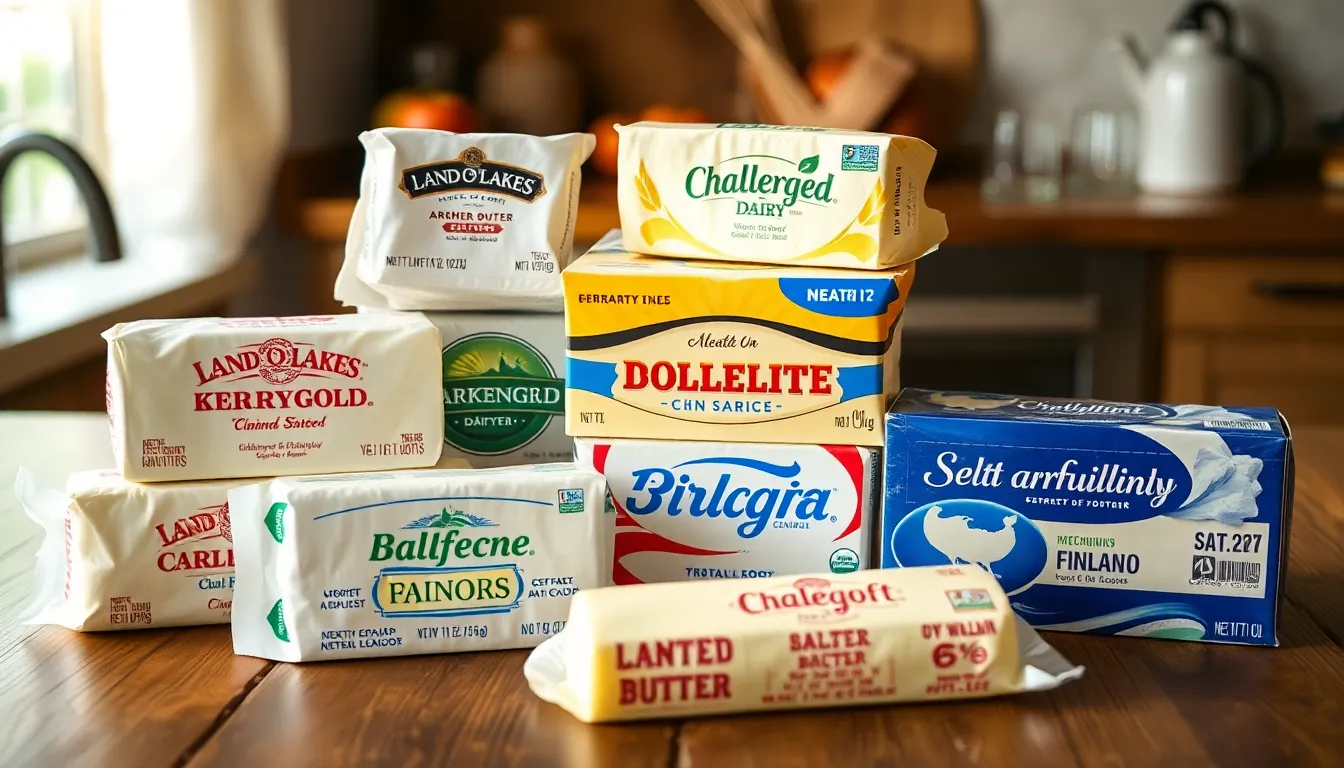Salted butter is a staple in many kitchens, prized for its rich flavor and versatility. But how much salt is actually in salted butter? This question often arises for those looking to manage their sodium intake or simply curious about their cooking ingredients.
Typically, salted butter contains around 1.5% to 2% salt, which enhances its taste and preserves its freshness. Understanding the salt content can help home cooks make informed choices, whether they’re baking, cooking, or spreading it on a slice of bread. As the demand for healthier eating grows, knowing the specifics of ingredients like salted butter becomes essential for both flavor and health.
Table of Contents
ToggleOverview of Salted Butter
Salted butter consists of cream and salt, enhancing taste while preserving the product. Typically, salted butter contains between 1.5% and 2% salt by weight. This salt content varies based on brand and production methods, impacting overall flavor.
Chefs and home cooks often choose salted butter for its ability to enrich dishes. The saltiness not only adds flavor but also acts as a preservative, extending the butter’s shelf life. Salted butter pairs well with baked goods, vegetables, and sauces, making it a popular choice in many recipes.
When considering dietary restrictions or sodium intake, knowing the salt levels in salted butter is essential. Those needing lower sodium options might opt for unsalted butter or adjust seasoning accordingly. Understanding the salt content in salted butter contributes to informed cooking choices.
Salt Content in Salted Butter Varieties

Salted butter varieties differ in salt content depending on the brand and production region. Understanding these differences helps consumers choose the right type for their cooking needs.
Common Brands and Their Salt Levels
| Brand | Salt Content (grams per 100g) |
|---|---|
| Land O’Lakes | 1.5 |
| Kerrygold | 2.0 |
| Challenge Dairy | 1.8 |
| Plugra | 1.9 |
| Finlandia | 1.5 |
Common brands often standardize their salt levels to enhance flavor without overwhelming dishes. For instance, Land O’Lakes contains about 1.5 grams of salt, while Kerrygold offers a slightly higher content of 2 grams. Consumers may prefer brands based on flavor preferences or dietary guidelines.
Comparison of European vs. American Salted Butter
European salted butter generally has higher salt content than its American counterparts. Typically, European options contain around 2 grams of salt per 100 grams, while American varieties range between 1.5 to 1.8 grams.
Variations in butter styles reflect culinary traditions; European butter often emphasizes flavor through higher salt levels, benefiting many recipes. In contrast, American salted butter focuses on a milder saltiness, appealing to different cooking methods and tastes. Understanding these distinctions aids in selecting the appropriate butter for specific dishes.
Health Implications of Salted Butter Consumption
Salted butter consumption impacts health due to its sodium content. Awareness of sodium intake becomes critical for individuals monitoring their health.
Recommended Daily Sodium Intake
The recommended daily sodium intake varies. The Centers for Disease Control and Prevention (CDC) suggests a limit of 2,300 milligrams (mg) for most adults. Individuals with specific health conditions, such as high blood pressure, may benefit from a lower limit of 1,500 mg. Given that a tablespoon of salted butter contains approximately 90 mg of sodium, it’s essential to factor this into the overall daily sodium consumption.
Possible Health Risks of High Salt Intake
High salt intake poses several health risks. Excessive sodium can lead to hypertension, increasing the risk of heart disease and stroke. Studies indicate that reducing sodium intake can significantly lower blood pressure levels, improving cardiovascular health. Additionally, high sodium consumption may contribute to kidney disease and osteoporosis by affecting calcium absorption. Individuals monitoring their health, particularly those with existing conditions, should consider these risks when using salted butter.
Cooking and Baking with Salted Butter
Salted butter adds a distinct flavor to a variety of dishes, enhancing overall taste while providing a degree of preservation. Understanding its role in cooking and baking helps in creating delicious meals and baked goods.
Flavor Considerations
Flavor plays a crucial role when using salted butter in recipes. Salt boosts sweetness and balances flavors in savory dishes, which is particularly beneficial when cooking vegetables, meats, and sauces. When using salted butter, it’s essential to adjust additional salt in recipes to avoid overpowering the dish. Recognizing the salt content in both the butter and a recipe can ensure proper taste balance, enhancing the culinary experience.
Substituting Unsalted Butter
Substituting unsalted butter for salted butter requires careful consideration. Unsalted butter offers a more neutral flavor profile, allowing complete control over salt levels in cooking and baking. When replacing salted butter with unsalted butter, it’s necessary to add about 1/4 teaspoon of salt per 1/2 cup of unsalted butter for accurate seasoning. This adjustment maintains flavor integrity in baked goods like cookies, cakes, and pastries while also ensuring savory dishes remain properly seasoned.
Understanding the salt content in salted butter is essential for anyone who enjoys cooking or baking. With typical salt levels ranging from 1.5% to 2% by weight, it’s crucial for managing sodium intake and making informed ingredient choices.
Salted butter not only enhances flavor but also serves as a preservative, making it a staple in many kitchens. For those mindful of their health or dietary restrictions, knowing the variations among brands and types can help in selecting the right butter.
By being aware of the sodium content and adjusting recipes accordingly, individuals can enjoy the rich taste of salted butter while maintaining a balanced diet.


